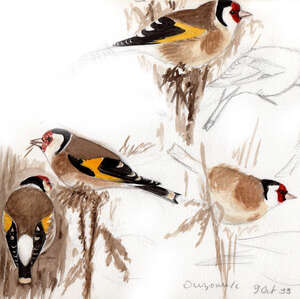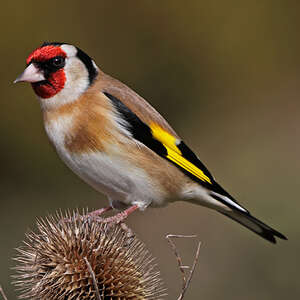European Goldfinch
Carduelis carduelis - Chardonneret élégant
Identification
The European Goldfinch is a small passerine bird, smaller than a sparrow and easy to recognize. Indeed, the adult has a reddish face and a large lemon-yellow area on the wing. There is a slight sexual dimorphism which, if one can say, does not jump to the eye. The male has the red of the face overflowing the eye towards the back while in the female, the red stops at the level of the eye. The rest of the head is black and white. The dark eye is included in a black loral zone. The beak, regularly conic, is pale pink. The upper body (cloak, back and shoulder blades) is brown-cashmere, except for the rump and the sus-caudales which are white, which can be well seen in the bird in flight. The brown of the top gains the sides of the chest where it forms two clearly visible pectoral spots, and the flanks, while the rest of the bottom is white. Wings and tails are black with white spots on the remiges and rectrices. The large yellow band that cuts the wing in two lengthwise is very visible on the bird in flight. The legs are pink or rosâtre depending on the season.
The juvenile can be recognized as a goldfinch by the yellow band on the wing and is very easily distinguished from the adult by the absence of red on the face. In addition, the head and underside of the body are whitish beige and finely streaked with brown.
The birds of the eastern subspecies, caniceps or subulata, have a head and upper body of a fairly pale gray-brown.
Subspecific information 10 subspecies
- Carduelis carduelis carduelis (s Scandinavia to c France and Italy and east to c European Russia)
- Carduelis carduelis britannica (British Isles, nw France and w Netherlands)
- Carduelis carduelis parva (sw Europe, nw Africa, Madeira, Balearic and Canary Is.)
- Carduelis carduelis tschusii (Corsica, Sardinia and Sicily)
- Carduelis carduelis balcanica (Balkans, Greece, Crete and nw Turkey)
- Carduelis carduelis niediecki (Middle East)
- Carduelis carduelis brevirostris (e Turkey, s Caucasus and n Iran)
- Carduelis carduelis colchica (n Caucasus and Crimea. s Ukraine.)
- Carduelis carduelis volgensis (s Ukraine, s European Russia and nw Kazakhstan)
- Carduelis carduelis frigoris (sw and sc Siberia)
Foreign names
- Chardonneret élégant,
- Jilguero europeo,
- pintassilgo-europeu,
- Stieglitz,
- tengelic,
- Putter,
- Cardellino,
- steglits,
- Stillits,
- stehlík obyčajný,
- stehlík obecný,
- Stillits,
- tikli,
- cadernera europea,
- Þistilfinka,
- szczygieł,
- dadzītis,
- lišček,
- Щегол,
- ゴシキヒワ,
- 红额金翅雀,
- steglits,
- 金絲雀,
Voice song and call
The typical calls are tsi du dut, ti pi dit, a rising tchuii etc. During arguments, a discordant whistled call is emitted in rapid series.
The song is quite a melodic phrase which has the tone of the calls it regularly includes, with rolled notes, accelerations, all very characteristic of the European Goldfinch species.
Habitat
The European Goldfinch is a relatively common bird of open wooded areas, whether deciduous or mixed. It can thus be found at the edge, clearings and forest regeneration, in the wooded steppe, in riparian forests along watercourses and bodies of water, in the garrigue or Mediterranean scrubland, in the hedgerow, along roads, and in anthropic environments in parks, orchards and wooded gardens.
Behaviour character trait
The European Goldfinch is a gregarious species, typically outside of the breeding season. This aggregation starts after the emancipation of the young from the first nest and lasts until the following breeding season.
Groups of several dozens of birds fluttering together, feeding together in tall grass or on berry-bearing trees can be seen. Some frequent urban feeders where they don't shun sunflower seeds. Migration and dispersal movements are done in small, tight groups.In the beginning of spring, however, groups disperse and already formed couples pick their nesting territory. Territoriality is quite weak in this species and several couples may occupy the same area. Despite that, the male finch is rather aggressive and easily aggrieved. The breeding display takes place in winter amongst groups. The male approaches the desired female, curves his back while turning from right to left, beating his wings alternatively probably to show off their yellow colour and spreading his tail to expose the white spots of the rectrices. The parade also includes offering food, which the female accepts by bending forward, trembling wings, as a young bird being fed. There are also chases, punctuated by repeated calls. When nesting time comes, the female is the one that builds the nest, accompanied by a male aware of potential dangers. When there are young at the nest to feed, the couple will shuttle between food territories and the nest in search of seeds.
Flight
Dietfeeding habits
The European Goldfinch is predominantly granivorous. It feeds on a wide variety of seeds in all seasons, both herbaceous plants, particularly asteraceae (thistles, asters, tussilage, etc.), but also trees (birches, alders, pines, etc.). In winter, it often visits feeding places, attracted by the seeds provided there, not at all by fat or other animal-based substances.
Reproduction nesting
The female builds the nest in a bush or a tree, typically in a fork not far from the end of a branch, at an average height (2 to 10 m).
It is a small, compact nest with very careful construction. It is made of moss and herbs, possibly agglomerated with spider silk. The interior is lined with soft elements such as plant down, willow or poplar seeds, sheep's wool, or feathers. Lichens are incorporated into the wall.The female lays 4 to 5 pale blue spotted eggs with reddish-brown. Incubation lasts 12 to 14 days and starts with the laying of the third egg. The female performs the incubation alone. She is fed by the male at the nest during this period.
Both parents feed the young mainly with water-soaked regurgitated seeds from the gizzard. The young leave the nest after 13 to 16 days, and the parents still feed them for a week. At the young's flight, the edge of the nest is completely covered with their droppings, which means that at the end of the nest-raising, the adults no longer evacuate the droppings from their chicks.
In the majority of the area, European Goldfinches can raise two successive broods.
Geographic range
The distribution area extends from the Atlantic (Ireland, Spain, Maghreb, including Madeira and the Canary Islands) to Lake Baikal in the east of the continent, centered on temperate latitudes. To the north, this area reaches the south of Fenno-Scandia and follows the south of Siberia. To the south, it is fragmented in the extreme northeast of Africa and only becomes continuous from Anatolia. It skirts the Caspian Sea to the south, passes through the south of Central Asia and then reaches Siberia via the Altai. An extension occurs in the west of the Himalayas. 12 subspecies share this rather wide area. Continental Europe is occupied by the carduelis type ssp. The species is renowned to be sedentary in the majority of its area. But oriented movements are noteworthy at the bird migration monitoring points, which suggests that the populations are all the more prone to significant seasonal movements, the more northerly they are.
Threats - protection
IUCN conservation status
concern
in the Wild
threatened
evaluated
The European Goldfinch is still currently a common species, not threatened at continental level. However, it is certain that the deterioration and banalization of rural landscapes, the disappearance of many uncultivated areas in favor of urbanization or productivist agriculture, can only have a negative effect on finch populations in our developed countries.
At one time it was a caged bird and captured for this purpose.
Currently, the species is protected and illegal trapping. But it is certain that poaching continues in many Mediterranean countries, including European ones, despite the protection laws. One only has to think of what happens in Cyprus or Malta every year.
Sources of information
- IOC World Bird List (v15.1), Gill, F and D Donsker (Eds). 2025-12-07.
Other sources of interest
 Specification sheet created on
05/07/2023 by Jean François
Specification sheet created on
05/07/2023 by Jean FrançoisTranslation by AI Oiseaux.net
© 1996-2026 Oiseaux.net
- Accipitriformes
- Aegotheliformes
- Anseriformes
- Apodiformes
- Apterygiformes
- Bucerotiformes
- Caprimulgiformes
- Cariamiformes
- Casuariiformes
- Charadriiformes
- Ciconiiformes
- Coliiformes
- Columbiformes
- Coraciiformes
- Cuculiformes
- Eurypygiformes
- Falconiformes
- Galliformes
- Gaviiformes
- Gruiformes
- Leptosomiformes
- Mesitornithiformes
- Musophagiformes
- Nyctibiiformes
- Opisthocomiformes
- Otidiformes
- Passeriformes
- Pelecaniformes
- Phaethontiformes
- Phoenicopteriformes
- Piciformes
- Podargiformes
- Podicipediformes
- Procellariiformes
- Psittaciformes
- Pterocliformes
- Rheiformes
- Sphenisciformes
- Steatornithiformes
- Strigiformes
- Struthioniformes
- Suliformes
- Tinamiformes
- Trogoniformes

































